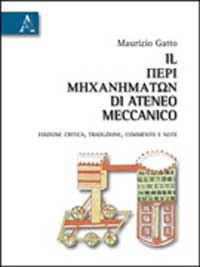Bryn Mawr
The ancient ways of war are endlessly fascinating for that elusive audience, the general public. Every time I teach Greek or Roman history, there is always someone in my class of adult learners who knows everything about the phalanx, or wants to hear more about tactics at the battle of Gaugamela, or is disappointed that I do not devote the entire course to the ethos of Roman legionaries. There is a definite appetite for ancient military history, but at the same time, the literary evidence on which we base our understanding of the technicalities of the ancient Greek and Roman ways of doing war remains relatively obscure. Much of the secondary literature from which popular knowledge of ancient military history derives, does not properly acknowledge the complexity and often partiality of the extant evidence. Passages abstracted from Polybius, Livy, or Arrian are made to bear the weight of unfeasibly detailed reconstructions of army formations and battle strategies, with hardly any concession to the ancient historian's overall aims and agendas. Meanwhile, the treatises which are explicitly concerned with war stratagems, techniques and machines, have received comparatively little attention, even among academics.Frontinus' Stratagems or Hero's treatise on catapults may not get many readers, but they are still relatively well-known compared to Athenaeus Mechanicus. His one extant work, traditionally called Peri Mechanematon, has gone mostly unnoticed for a long time. The first English translation dates to 2004,1 and it is based on a critical edition of the Greek text which was itself in need of revision, as Gatto explains in his introduction (xxxiii). The present volume thus offers not just an Italian translation, but also a new edition of the Greek text, based on an exhaustive survey and analysis of the extant manuscripts.There were many Athenaeus in antiquity - our author, nicknamed Mechanicus because of the content of his only surviving work, has been persuasively identified with a Peripatetic author, from Seleucia, active around the middle to the end of the first century BC, in Rome among other places (chapter 2). The short treatise (less than 400 lines) is addressed to a Marcellus, who can be identified with Marcus Claudius Marcellus, son of Octavia and nephew of the emperor Augustus. If the identification stands, the work must have been written before 23 BCE.Athenaeus begins by reminding the reader of the importance of time: it is so precious that it should not be wasted, especially not in reading over-long treatises (208-11). Athenaeus thus purports to be brief and to the point: he is going to talk about machines, in particular those useful in the course of sieges. He mentions the mechanician Agesistratus as one of his main sources, and starts to describe various devices, commenting on the history of their discovery and successive development, their specifications and building materials, as well as details about their use. We start wit the ram, first discovered by the Carthaginians at the siege of Gades (213). To follow, we have mobile siege towers, which are allegedly to be credited to Diades, along with the siege drill and other devices, some of which Athenaeus does not think worthy of description (215-9). A third source, Philo of Athens (evidently, Athenaeus here means Philo of Byzantium, a well-known mechanical author), provides material for a description of a type of "˜tortoise', i.e. a mobile shelter for soldiers, used to facilitate the levelling of terrain (219-20), while Hegetor of Byzantium is mentioned with reference to a ram-equipped "˜tortoise' (221-6). The well-known siege-tower called helepolis (226-7) ushers in another section, devoted to ineffective machines, and, shortly after that, a section on machines of Athenaeus' own devising, including the so-called "˜little monkey', which stabilizes ships carrying siege engines, and two more types of "˜tortoise' (230-6). Athenaeus concludes the treatise thus: "Do not suppose us to be so cruel as to have collected all these commentaria about destroying cities. On the contrary. What has been said in this treatise makes a city safe; for those who know these things will easily be able to guard against what will harm them. Our main business had been directed against those who will not submit to the fine laws of the empire. Hence, if you see fit, all the machines will come illustrated with plans; and what is hard to describe in words will be clear to see from them. As for the measures needed to counter what has been discussed, if we collect any from the ancients we will try to describe those too for you. This statement has been made because there are some people who measure their neighbours' capacity for toil by their own idleness, and who deny that in much (of this) there is practical knowledge to be had, as if learning could cramp the enthusiasm of our spirit."(236-7)2To summarize, Athenaeus is a Greek, writing for a Roman addressee, and not j
Link al sito









